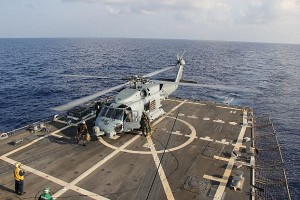 The Navy’s new budget suggests that the humble Navy helicopter has fallen out of favor.
The Navy’s new budget suggests that the humble Navy helicopter has fallen out of favor.
Traditionally, the simple ole’ helicopter has been one of the more effective means for surface ships to pursue Anti-Submarine Warfare (ASW) and Anti-Swarm operations. The run-of-the-mill helicopter remains critical for surface combatant resupply, personnel transfer and (sometimes) ISR. It adds flexibility. But a glimpse at the Navy’s proposed budget suggests the simple Navy helo is being de-emphasized. The MH-60R (a surface warfare and ASW asset–see pic above) was cut, the Firescout zeroed out, and even heavy-lift CH-53K production sliding right (again).
It’s quite a mysterious come-down. For the rotary-wing crowd, gone are the heady days when the Congressional Budget Office used “available helicopter hangars” as a measure of fleet strength (other principal measures of surface fleet strength in CBO studies are usually the intrinsic number of surface combatants themselves, followed by the number capable of providing long-range fleet air defense, the number of VLS cells, long range guns, and ASW suites.).
While VLS cell numbers and Ballistic Missile Defense capabilities have become the primary quantitative focus of most mainstream naval strategists today, the reduction in helicopter hangars available within the surface combatant fleet and consolidation of helicopter support onto larger platforms has been comparatively overlooked.
It’s all somewhat odd, because the helicopter remains an integral part of naval warfare. Every young Navy out there is looking for a naval helicopter. Rotary wing airframes support every aspect of modern war at sea, and it is one of the key areas where the U.S. has a real advantage over almost everybody else.
Unless helicopters are facing an overwhelming tactical overmatch from small, undersea-launch-capable surface-to-air missiles or portable swarm-ready weapons, the advantage of having a cost-effective, dispersible, well-understood and highly mature platform available to operate across a range of different naval platforms seems difficult to deny.
But the Navy’s FY-15 budget documents do a pretty good job of sidelining the humble helicopter–denying the value of a tried-and-true, always-in-demand asset.
The underlying reason for the helicopter cuts is that the number of US surface combatants with helo hangars is in precipitous decline. The Navy is slashing the available numbers of cruisers and other helo-ready surface combatants–in numbers far beyond what is getting added back by vessel recapitalization.
The numbers are stunning. In 2007, the CBO estimated the overall US helicopter hangar number at around 150. Today, if the budget stands, we’ll eliminate over 50 of those hangars in the space of a few fiscal years. The the two-helo hangar FFG-7 class will be totally eliminated in FY 15, and 11 two-helo hangar cruisers are set to be put “into ordinary”, leaving the fleet with a serious shortfall in smaller combatants ready to support helicopters.
Deleting at least 52 hangars from the surface combatant fleet in FY-14 and 15 (11 CGs, 9 Active FFG-7s and 6 NRFA FFG-7s) is…worth thinking about a bit. Aside from reducing the flexibility of the force, deleting these hangars make it harder to incorporate new UAV platforms and, possibly, employ other interesting capabilities.
Once shed, hangars won’t be quick to come back. In FY 15 only 4-6 hangars come back to the Fleet via 2 Indy and 2 Freedom Class LCS. And overall, with the Littoral Combat Ship is being delayed/cut–all while being artificially constrained by a CONOPS that limits LCS helo ops to a single helo (I suspect the INDY Class can accept two MH-60s easy, thus the 4-6 number above)–no help is in sight.
Additional Burke Class buys won’t add much either–the shift from the Flight IIa Burkes is imminent, and there are rumors are that the Flight III Burkes will sacrifice one of the Flight IIa’s two hangars for power generation or something. (Remember, of the DDG-51 Class Destroyers, only DDGs-79 and up have helicopter hangars.) DDG-1000 adds two.
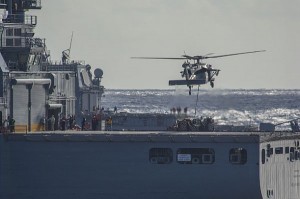
The only hope to add helicopter hangars quickly is via the MSC Fleet (add hangar-space to the T-AO(X)s) or through the incorporation of some extra amphibs. The addition of AFSBs is a good step, but, remember, while these bring utilitarian aviation-ready goodness to the fleet, they’re awfully slow (18Kt max speed) and more of a stationary in-theatre asset than combatant or fleet escort. But the hangars available on the MSC’s logistical support fleet might be useful if the lawyers allowed ’em to carry (and rearm) combat helos.
Adding back this capability depends upon the Navy’s commitment to old-school rotary wing craft. But…if the FY-15 budget is any guide, something has happened to dramatically reduce the importance the surface fleet places on organic helicopter support.
Helos in Fleet Operations:
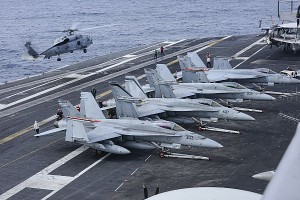 Larger task forces are increasingly reliant upon the larger big-decks for helicopter support, leading me to wonder if the surface combatant community is quietly distancing themselves from the old-school rotary-wing workhorse.
Larger task forces are increasingly reliant upon the larger big-decks for helicopter support, leading me to wonder if the surface combatant community is quietly distancing themselves from the old-school rotary-wing workhorse.
It’s only logical–helos have nowhere else to go. Despite the planned “bulking up” of the number of CVN escort ships, the remaining hangar-equipped surface combatants will be in short supply, siphoned away by special missions. For example, independent employment of BMD-capable surface combatants in BMD “national mission” roles will, in time, inevitably draw from the supply of DDG-51s with hangar space—early-Flight Burkes are unlikely to be dedicated to solo BMD patrols (or really any really useful “presence” patrol at all in tense areas with an undersea/swarm threat (see comments below).
It makes the big-deck the only logical place for the Navy’s helicopters to be housed. And that shift in community means the helicopter fleet may have been left without a committed champion, ripe for marginalization and–as we are seeing–defunding.
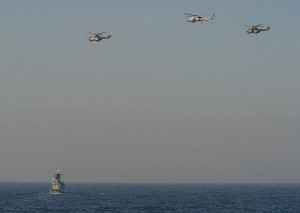 The reinvigoration of the CVN’s long-range strike mission makes the condensation of rotary wing assets to the carrier look like a relatively short-term fix. Just as MH-60R-equipped Maritime Strike Squadrons are getting nice and comfy aboard their carriers, they’ll be tossed out–as anti-A2/AD strategists realize that a short-range rotary wing craft makes a poor fit for a big deck CVN prepping for long-range anti- A2/AD strike missions.
The reinvigoration of the CVN’s long-range strike mission makes the condensation of rotary wing assets to the carrier look like a relatively short-term fix. Just as MH-60R-equipped Maritime Strike Squadrons are getting nice and comfy aboard their carriers, they’ll be tossed out–as anti-A2/AD strategists realize that a short-range rotary wing craft makes a poor fit for a big deck CVN prepping for long-range anti- A2/AD strike missions.
I am willing to bet that moving the helo to the big-decks has stripped the humble helo of champions. I fear that the helo is becoming an expensive, labor-intensive piece of “un-owned, in-common” equipment whose operating costs are best foisted upon “Somebody Else’s” O&M budget.
Remedies:
Barring some game-changing tactical threat (missile overmatch or, oh, lasers!!), rotary-wing airframes will remain an important part of the naval arsenal. Even though rotary-wing manned/unmanned airframes will become more efficient and evolve technically over time, the fleet will still benefit from the flexibility of having a good number of hangars (with organic, rotary wing assets) dispersed throughout the small-combatant fleet.
What are the options for rehabilitating the humble helo?
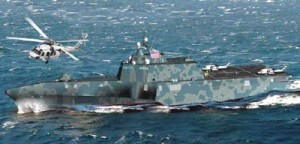 The first thing to do is to make sure the helicopter remains an organic component of certain surface combatants (the accountant-warriors among us will scream and gnash their teeth, but I think commanders are more prone to think harder about using assets that are under their direct command). I appreciate the efficiencies that come with keeping wings on carriers, but I like the idea of some surface combatants “owning” their own helos.
The first thing to do is to make sure the helicopter remains an organic component of certain surface combatants (the accountant-warriors among us will scream and gnash their teeth, but I think commanders are more prone to think harder about using assets that are under their direct command). I appreciate the efficiencies that come with keeping wings on carriers, but I like the idea of some surface combatants “owning” their own helos.
The second thing to do is to get more hangars out into the fleet. To do that, I’d ensure that the Indy LCS Class’s ability to support rotary wing craft is not being artificially throttled. The LCS draft CONOPS has reduced the LCS aviation requirements to one manned and one or two unmanned systems “depending upon the mission”. This, in my opinion, is largely in deference to the space limitations of the LCS-1 seaframe; LCS-2—if the mission bay is utilized for maintenance and storage–offers far more aviation capability that, under the current CONOPS, goes unused. The requirement to maintain a 23 person AVDET (28-31 required for around-the-clock aviation operations) means that the ship may have a more difficult time conducting other operations; therefore, the Navy should be encouraged to support mission sets that leverage the full utilization of all the Indy Class aviation capability—an almost exclusive focus on aviation, or a solely “rotary-wing-based mission module”, so to speak.
Assuming a helo can withstand the accelerations on a trimaran LCS at a high sea-state, inclusion of a helicopter recovery system (RAST, etc) aboard LCS might also support flight operations over a larger range of sea states.
Also, when operational, the Indy Class elevator to the mission bay is an enormous force multiplier. Bolstering the elevator (expanding the footprint and max allowable weight) should become a priority in future—capability to store and service larger, more sophisticated “higher-endurance” platforms or other UAVs outside the hangar will prove less of a burden to the slimly-manned ship.
Third, unless there’s a compelling operational argument, I’d be loathe to sacrifice hangar space on the Flight III Burkes for power generation equipment (hopefully sanity will prevail, but, these days, one never knows!). As much as I like lasers and power generation, a hangar makes the ship far more useful in a wider range of missions.
If helicopters are too much of a burden or aversely impact the larger surface combatant mission (constraining, say, certain EM emissions), then it might be useful to eye the helicopter-destroyer hybrids in service in Japan–something simple that can support a carrier strike group, yet be of low-enough value to operate at the margins of the escort screen, pushing significant rotary-wing support forward. And perhaps, as the idea of a flotilla mother-ship advances, then an amphib could be used as a home-base as helos are distributed to the tiny flotilla combatants.
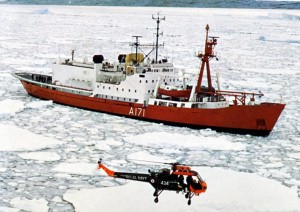 Also, possibly, let’s get the lawyers to reconsider deploying combat-ready helicopters from MSC ships–last time I checked, they usually have nice hangars, and with the T-AO(X)s in the design phase, there might be an opportunity to add some cost-effective hangar-space and weapons storage capability. Don’t knock it! Simple civil-spec ships can contribute on a tough battlefield–After all, let’s just take a moment and remember how useful the humble, two-helo HMS Endurance was back in 1982–and how her embarked choppers helped sink a sub–during the Falklands conflict.
Also, possibly, let’s get the lawyers to reconsider deploying combat-ready helicopters from MSC ships–last time I checked, they usually have nice hangars, and with the T-AO(X)s in the design phase, there might be an opportunity to add some cost-effective hangar-space and weapons storage capability. Don’t knock it! Simple civil-spec ships can contribute on a tough battlefield–After all, let’s just take a moment and remember how useful the humble, two-helo HMS Endurance was back in 1982–and how her embarked choppers helped sink a sub–during the Falklands conflict.
And, finally, I’d keep working with the Army to improve interoperability between Army rotary-wing assets and Navy platforms. Army/Navy collaboration in rotary wing support makes sense, but without adequate hangar support at sea, that collaboration gets far, far harder.
Conclusion:
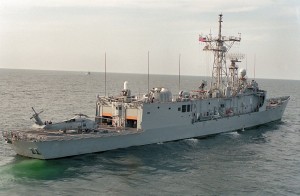 It’s easy to neglect something that is so ubiquitous. There’s nothing special about helicopters anymore, and they’re just part of the boring old routine of Navy life. They’ve faded into the background.
It’s easy to neglect something that is so ubiquitous. There’s nothing special about helicopters anymore, and they’re just part of the boring old routine of Navy life. They’ve faded into the background.
It’s a shame–helos are important parts of the surface warfare arsenal, and to see them moving away from being organic surface combatant assets to something that belongs more to the big-deck folks…it feels wrong, and it moves the helicopter away from being an integral piece of the surface warrior’s consciousness.
As an example of how the helicopter is being disconnected from the surface warfare community, I’d go and compare, say, early reports on LCS mission modules with ones produced today. Early reports cite the enormous importance of helos in fighting the LCS mission package. Later ones barely mention the helo (which is, for me, particularly amusing, since the helo is the most successful component of any LCS mission package).
Failure of the surface warfare community to highlight the support brought by rotary-wing assets means the Navy may overlook a strength that, in the past, united the fleet. We forget that the humble helo facilitated the U.S. Fleet’s acceptance of new and modest platforms—i.e. the FFG-7 Class–at a time when the FFG-7 itself was facing the same sort of criticism now leveled at the LCS. But the FFG-7 brought helos forward at a time when the Navy needed ’em, and that set the stage for the support FFG-7s still enjoy today.
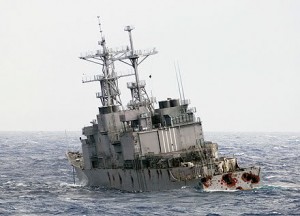

{ 16 comments… read them below or add one }
Recent CSBA report by Bryan Clark barely mentions MH-60. Lots of problems with that report.
I think surface community is very disconnected from what helos brings to fight (ASW, counter-swarm, etc.) Its a very valuable extension of surface ship. In case of LCS… its the only way to localize and kill a sub.
I don’t know why there isn’t any love for the rotary wing. I just don’t get it.
Funny, they don’t seem to be having any trouble finding room for the V-22 Osprey…
While I do not have experience with your NAVAIR standards / requirements – I expect there are probably some parallels with most other technical regulatory / airworthiness / sea worthiness systems in place. We are writing regulation in peacetime that impose a substantial cost and burden, which I have little doubt will be modified substantially should we face a genuine existential threat to our fleets.
In peace time it is very difficult to explain any avoidable deaths and injuries that might have been prevented through better regulation and compliance. In war time I suspect it will be harder to explain the preventable deaths that might occur through failing to do what needed to be done due to excessive regulation. May we never have to face such a circumstance.
Thanks for the note Wireguided–
Regarding your very last comment…..Anybody out there believe the NAVAIR standards/requirements for hangars have gotten a little out of hand?
Craig,
Agree entirely with post. Once USN realized the value of the manned helicopter they added the potential carrying of it to the fleet in a big way. The Spruance, Kidd, Ticonderoga, and Perry classes all had hangars big enough for two SH-60s. The USN felt that there was so much hangar capacity fleet wide that the Burke was designed with no hangars – In my opinion a mistake.
The decline in hangar capacity is also matched in the decline in the Navy reserve. The USN used to have more aircraft in the reserve during the Cold War. I think it would be interesting to compare the total number of SH-60/SH-2 in active and reserve units in 1991 to today.
The normal optempo is probably one helo on a CG or DDG, as El Sid pointed out. But it is nice to have the option of two if needed. Say, for Pacific based ships in a crisis.
I also believe the Independence LCS can carry more aviation assets that advertised. And with a little tweaking can carry a lot more.
I know, I know….is there even a notional schedule for adding BMD to the IIA?
Craig,
I think you’re still conflating two mutually exclusive capabilities. At the moment, there are ZERO BMD-capable Flight IIA DDGs. Should a BMD patrol need to be conducted in an area with a significant USW threat that required the presence of a helicopter, an additional asset (FLight IIA DDG or other) would need to be tasked in addition to a BMD-capable Flight I/II DDG.
Shorter version: BMD=Flight I/II DDG, Flight IIA (Helo hangers) = No BMD
Regards,
Joel
Joel–
Hey Sir! You are quite correct! Should have emphasized that, in my opinion, in tense and contested areas with a significant undersea threat, BMD patrols will be conducted by the Flight IIAs…
My sense is that, in time, the early flight DDGs will move exclusively to lower-threat regions or into larger strike groups. Or they’re gonna have a helo-hangar-equipped ship…or some other asset nearby.
Nice catch and thanks for keeping me honest! A distinct pleasure having you as a reader…
Correction to my last…it should read:
*The fact is that all solo BMD “national mission” patrols (independent or otherwise) are conducted by DDG-51s WITHOUT hangars. All of the current BMD-capable DDG-51s are Flight I/II hulls (53-78, exclusive of 58, 66, 67, 68, 72), while the Flight IIA DDG-51s with hangars start at hull 79, USS OSCAR AUSTIN. Thus, all DDG BMD patrols are conducted by ships without hangars — the opposite of what you convey.
Craig,
There are a couple of details that are portrayed incorrectly that I think need correcting that may affect your premise.
You write “…independent employment of BMD-capable surface combatants in BMD “national mission” roles will inevitably draw from the supply of DDG-51s with hangar space—early-Flight Burkes are unlikely to be dedicated to solo BMD patrols (or really any really useful “presence” patrol at all).”
The fact is that all solo BMD “national mission” patrols (independent or otherwise) are conducted by DDG-51s with hangars. All of the current BMD-capable DDG-51s are Flight I/II hulls (53-78, exclusive of 58, 66, 67, 68, 72), while the Flight IIA DDG-51s with hangars start at hull 79, USS OSCAR AUSTIN. Thus, all DDG BMD patrols are conducted by ships without hangars — the opposite of what you convey.
ATIS– Yessir. You are so right. There’s a lot to be said for a simple, robust and reliable “no frills” platform that could just get the job done–and the S-3 certainly was that.
I do have to wonder if the cost-saving devolution of helos to the carrier air wing was a result of shrinking the overall size of the escort group.
Always a pleasure to have folks from your area reading the blog.
Chris–
I think you are onto something. I hate needing to “rebadge” or “repackage” something whose benefit should be known, but I guess that’s the way of life for successful pieces of kit these days. Sort of a “Reinvent or Die”–where if you’re not EXCITING! or INNOVATIVE! you’ll fall right out of the budget…
Without seeming too glib, perhaps rebadging the helicopter, and supporting shipboard organisation as a capability module might go some part of the way to reestablishing some appreciation of their flexibility and utility across the entire spectrum of operations.
We were all very enamoured with modular approaches to capability not too long ago – Helicopters have been providing this efficient and flexible approach to supporting naval and joint operations for many years now.
It was a mistake for the Navy to divest the S-3 Viking, instead of modernizing it to perform robust ASuW and ASW (in addition to its role as a tanker). The thought that helo’s could replace a long endurance, long range, armed carrier based fixed wing asset to become the sole SSC/ISR platform was flawed. It was an unfortunate decision driven by money and the priority shift to overland strike vice traditional blue water presence.
Hi Sid–
Nothing cute or coy about it. People compare the number of ships leaving the fleet with ships entering the fleet all the time. I just extend that to hangars.
Regarding NRFA ships– I am using the fleet numbers as provided by the NVR–Navy numbers straight up, with no interpretation, no chaser.
The hangar number reduction is fleetwide, not just classwide. LCS numbers are just a part of it. Yeah, LCS was meant to fill in for 30 Perrys/XOspreys/XAvengers/XPGs…but if you recall, some 50 FFGs were once in service with the Navy…I softpedaled this in the piece, but helo hangars have been shed from the fleet far faster than a lot of other stuff.
I am aware of operational patterns (yeah, I know where the FFG-7 crew gym usually is installed). But, again, Navy tells the public that the long FFGs now in service carry two helos. Again, Navy numbers straight up, with no interpretation and no chaser.
If the Navy wants to sway the discussion one way or another, then they should publicly provide the operational caveats needed to support their argument.
Also, it might be wise to think about what cutting the rotary-wing programs do to the Navy in twenty years–it sets us up for a precipitous age-out as our existing helos reach their operational limits….
Thanks for reading!
You’re being a bit cute comparing the complete removal of the Perrys with one year’s procurement of LCS. 55 LCS were intended to replace 30 Perrys, 14 Avengers and 12 Ospreys. Now it’s 32 LCS plus an unknown quantity of the Future Frigatey Thing. I fail to see how that represents a long-term reduction in the number of helidecks. Yes, there’s some short-term awkwardness which is chiefly down to the Ticos, on your figures for FY14 and 15, it’s down 9 active Perrys – and gaining 8 active LCS. You count NRFA ships – but what state are they in, and in any case do active Perrys actually carry two airframes? Are there airframes and trained crew available to surge on to those decks in the event of war?
As for MSC ships, you may want to note how the UK uses RFA motherships for anti-piracy/drugs/HADR – it all helps take the pressure off the main force, and actually it’s no bad thing to have ships with huge on-station endurance for those kinds of missions, they work quite well.